Nestlé is proof that goodwill efforts to enhance the lives of locals in China can create shareholder value for foreign companies.
It is “our firm belief that for a company to prosper over the long term to create value for shareholders, it must create value for society at the same time,” Bulcke, the CEO of Nestlé, said.
Driven by top-level management, Nestlé’s corporate social responsibility effort, “Creating Shared Value,” requires it to undertake 38 commitments to address five global issues: nutrition, rural development, water, environment sustainability and people, human rights and compliance. And this is not empty corporate rhetoric: Nestlé uses 58 key performance indicators to measure progress in a publically-accessible report; and this initiative is spelled out in actionable, measurable and accountable steps backed by corporate resources.
Their efforts in China all started with milk.
‘We often lost heart’
It was 1986 and some 37 years had gone by since Nestlé left China. Now the company was re-entering the country and inking a joint venture agreement with a state-owned enterprise in Shuangcheng, a county in Heilongjiang province.
The Cultural Revolution, during which time western brands were labeled as decadent, had just ended in 1976. China’s experiment with market economy had only began in the south about eight years ago.
Heilongjiang, China’s northernmost province, lagged economically behind the soon-to-be “factory of the world” southern and eastern provinces.
Understandably, Nestlé’s first joint venture came with reservations.
“It took us so long to get to this point (and) we often lost heart,” Mike Garret, Nestlé’s then regional head, told Fortune of the lengthy negotiations that began in 1979, as well as his apprehensions over rudimentary matters such as commercial viability and safe milk supply.
But, Garret said, “When a government asks for help, you’re on your way to building up valuable credit within a society.”
And so begins Nestlé’s work to craft goodwill in China.
courtesy of Nestlé | Nestlé’s ‘Factory and Farmers’ milk collection program in
Shuangcheng China, provides farmers like Zhengjun Wang with proper manure
storage.
Cows, milk and roads
As Nestlé built the Shuangcheng factory, it also paved roads for local farmers to deliver milk, which it paid for promptly, and this generated goodwill at a time when basic infrastructures were inadequate and bad debts were rife in China. And for good measure, Nestlé dispatched its Swiss experts to teach local farmers about caring for cows.
It was back to the basics, and another three to four years would pass before the first products eventually rolled off the Shuangcheng production lines in 1990.
Nestlé’s efforts to procure safe milk endeared them to many local farmers, and in turn, the local government.
From makeshift to the largest dairy plant in Asia
Twenty years later, in 2008, the melamine milk scandal broke in China, and this triggered a consumer crisis that was unprecedented in recent memory. Headlines such as “Six thousand babies sick from tainted Chinese milk” blazed across the front pages of newspapers and shocked the world.
Against this backdrop, Nestlé Shuangcheng held an open house to showcase its commitment to product quality and safety. As the company’s milk products were declared safe, Peter Brabeck-Letmathe, the chairman of Nestlé, proclaimed to Reuters, “All our products are 100 percent safe. … Sales in China are rather being favored.”
Nestlé attributed the quality and safety of its products to a number of key factors, one of which was the “win-win partnership between the farmers, local government and Nestlé.”
Backed by this goodwill, the Shuangcheng plant grew to become Nestlé’s largest Asia dairy production facility in 2008.
The coffee challenge in tea country
“When the authorities authorized Nestlé to set up a Nescafe factory at Dongguan, not far from Hong Kong, they asked our company to bring technical assistance to the coffee farmers in Yunnan to develop Arabica production,” Patrick Leheup, a Nestlé agronomist, said to Tea & Coffee Trade Journal.
Yunnan province, in southwest China near the Myanmar border, isn’t exactly at the doorsteps of Dongguan. It is more than 850 miles away, about the distance between New York and Chicago.
And it is one of the largest tea producing regions in China, a country that has consumed tea for centuries.
It would be a challenge.
But, true to form, Nestlé started coffee bean development in Yunnan in 1988. The company then founded Nestlé Dongguan in 1991 with a state-owned enterprise, followed by an agricultural assistance service center in 1992, and an experimental and demonstration farm in 1997.
Living on coffee beans
By 1997, Nestlé invested 20 million yuan to create goodwill in Yunnan: local farmers were trained on the finer points of cultivating coffee beans; and foreign experts were flown in as advisors on technical matters. Nestlé even went so far as to provide better varietals of coffee beans, and loans for fertilizers and pesticides.
Local farmers like Mr. Zhou, who had rewarded himself with a new Seiko watch, were no longer living in poverty. Mr. Huang, Yunnan deputy governor, was busily plotting how to use coffee bean cultivation to lift more local farmers out of poverty.
Mr. Zhou and about 400 families in his district were harvesting about 100 metric tons of coffee beans a year and aiming to harvest 400 metric tons in two years.
By 2012, Nestlé was buying 8,000 metric tons of coffee a year, or 20 percent of the crop, in Yunnan province. The company said it was supporting the livelihoods of 20,000 people.
Strategic insights
Nestlé’s goodwill amounts to more than a hill of coffee beans or herd of cows. The company contributed more than 10 million yuan to disaster relief and the rebuilding of Zhuwa Primary School in the wake of the 2008 Sichuan earthquake; and donated 25 new computers to Huang Hua Cheng School in suburban Beijing as Children Day gifts in 2002.
By reaching out to people like Mr. Zhou, the coffee bean farmer, and the students in Zhuwa and Huang Hua Cheng, Nestlé contributed to China’s massive efforts to lift millions of residents out of poverty.
Nestlé’s goodwill strategy enables it to balance the two significant, often competing, issues facing companies: creating shareholder value through value-chain activities and using social responsibility to enhance local stakeholder value in China. Of course, a goodwill strategy cannot address all issues, but Nestlé’s success here does provide a compelling case.
In its latest annual report, Nestlé presented some key numbers on the first page to show its performance.
In addition to metrics about corporate performance such as sales and trading operating profits, Nestlé also presented metrics in corporate social responsibility: 26 percent reduction in energy consumption; 52 percent reduction in water discharges; and more than 12,000 farmers sensitized on child labor issues, among others.
Companies can take cues from Nestlé for executing and measuring goodwill strategies. A goodwill strategy needs appropriate metrics to assess the viability of investments, track progress and execution, and review and adjust performance.
There is a catch
Not many foreign companies can afford the grandeur of Nestlé’s goodwill investments in China.
Money is practical consideration, of course, but metrics can be adjusted according to budget for goodwill efforts. So, this should not be a deterrent.
Each company should consider its home-based shareholders and stakeholders, as well as value-chain activities. Further, the needs of local stakeholders in China vary from city and industry, which means there is no one-size-fits-all strategy.
But the key remains constant: present a compelling case to secure buy-in; impetus from the top level; backing of long-term commitment and resources; and assess, track and recalibrate.






























